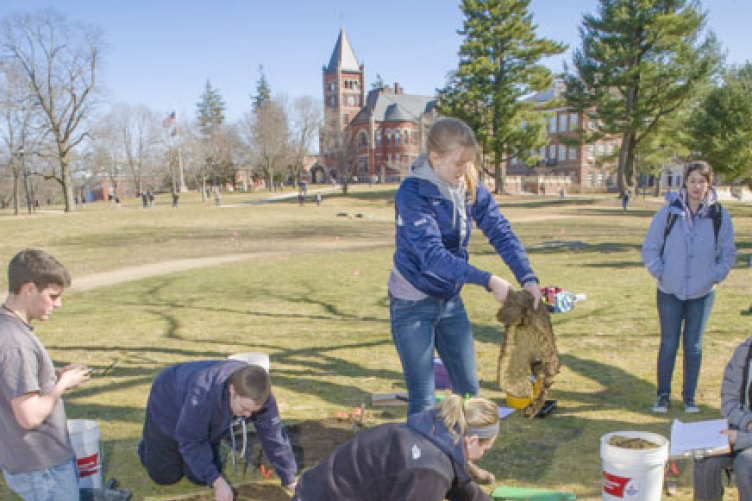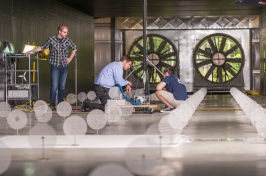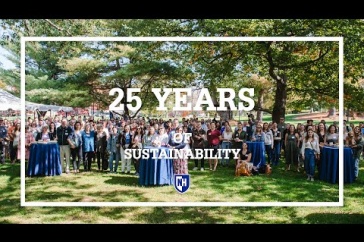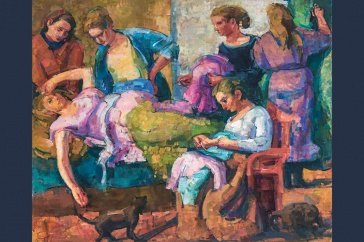
UNH students remove the topsoil at the archaeological site of the former UNH train depot near Morrill Hall. The students are excavating the site as part of their innovative course “The Lost Campus: The Archaeology of UNH.”
Students at the University of New Hampshire are unearthing the site of the original train depot that used to be on the great lawn near Morrill Hall until it was moved after a tragic 1905 train accident.
The archaeological dig is part of UNH’s innovative “The Lost Campus: The Archaeology of UNH” course taught by Meghan Howey, assistant professor of anthropology. This is Howey’s third archaeological dig on the UNH campus; previously UNH students under Howey’s direction excavated the site that once was home to the late Charles Holmes Pettee, a longtime UNH professor and dean, and the site of a World War I Army barracks.
“My hope is to build a longer-term commitment regarding UNH’s cultural heritage. When we have new building projects, I hope we consider our cultural and historical resources. When we think, we want to think big,” Howey says. “The land records and holds memory, and what happened at this site, even before UNH was here, is part of our cultural heritage and identity.”
When the New Hampshire College of Agriculture and the Mechanic Arts moved to Durham in the summer of 1893, the Boston and Maine Railroad transferred Dean Charles Pettee and his faculty--along with their books, equipment, supplies, desks, files, household effects and families--from Hanover to the new campus in a matter of hours.
The railroad split the campus in half, with the original tracks crossing Main Street at the point where Edgewood Road intersects it today. Of the five original buildings completed in 1893, two (Thompson Hall and Conant Hall) were on the east side of the tracks and three (Hewitt Hall, Nesmith Hall and the dairy barn) were on the west side. The railroad station was located just north of where DeMeritt Hall now stands.
In the days before automobiles became common, virtually everyone and everything coming to or departing from Durham traveled by train. It was not uncommon for students to take a train to Boston just to enjoy an afternoon in the city.
The train depot remained at the site until the trustees persuaded the railroad to move the tracks to their present location in 1912, when it was upgrading the line through Durham.
The decision was made following the Jan. 22, 1905, train accident. The St. John's express, headed south at about 50 miles an hour, struck a defective rail just about where Kingsbury Hall stands today. A number of cars were derailed, and 11 passengers were seriously injured. Within a few minutes, students and faculty members arrived and began assisting the 85 passengers out of the cars. Injured passengers were taken to nearby campus buildings, and the railroad sent a special train from Dover with doctors and nurses to care for them.
So far, the students excavating the site have found coal, slag, off-slag, bricks, wood, ceramics, nails, glass, and other items at the site that stretches from an area near the northeast corner of Morrill Hall along the lawn toward DeMeritt Hall.
While the course was Howey’s idea, the archaeological effort is student driven. Each semester students research several possible excavation sites on campus and then choose the site for their class dig.
“It is exciting to know that I have a part in a bigger thing. It’s very different from everything else I am learning. All of my other courses are very structured. It is interesting to find history in our own backyard,” says Emily Hutchinson, 19, a mechanical engineering student from Newton, Mass.
Allie Popovici, 19, a business administration student from Portsmouth, R.I., was hooked on the course as soon as she read its title when she was looking for a course that met her degree requirements.
“I expected the course to be a lot of historical facts and book learning, but it is so hands-on. When we found our first artifact, we were really excited. I’m so happy I decided to take this class,” Popovici says.
Craig Brown, one of Howey’s former undergraduate students who now is a doctoral student in archaeology at the University of Edinburgh, is assisting with the course this term as an adjunct professor. “Everything that has happened here is recorded in the ground so we are going to find artifacts from the train depot as well as artifacts from everything that has happened since,” he says.
The students will share what they’ve learned at UNH’s second Community Archaeology Day Saturday, April 27, 2013, from 9 a.m. to 3 p.m., when the public is invited to visit the dig site. Children are welcome but must be accompanied by an adult.
Originally published by:
UNH Today
-
Written By:
Staff writer | Communications and Public Affairs


















































